Home Safety Checklist For Dayton
Keeping safe in your residence should be your number one concern. But are you overlooking a few key safety items? Use this home safety checklist for Dayton and discover where your home requires an update.
This guide starts with a few whole-home safety techniques, and then we whittle it down to specific room ideas. Then, you can call (937) 230-5750 or complete the form below to speak to a security expert.
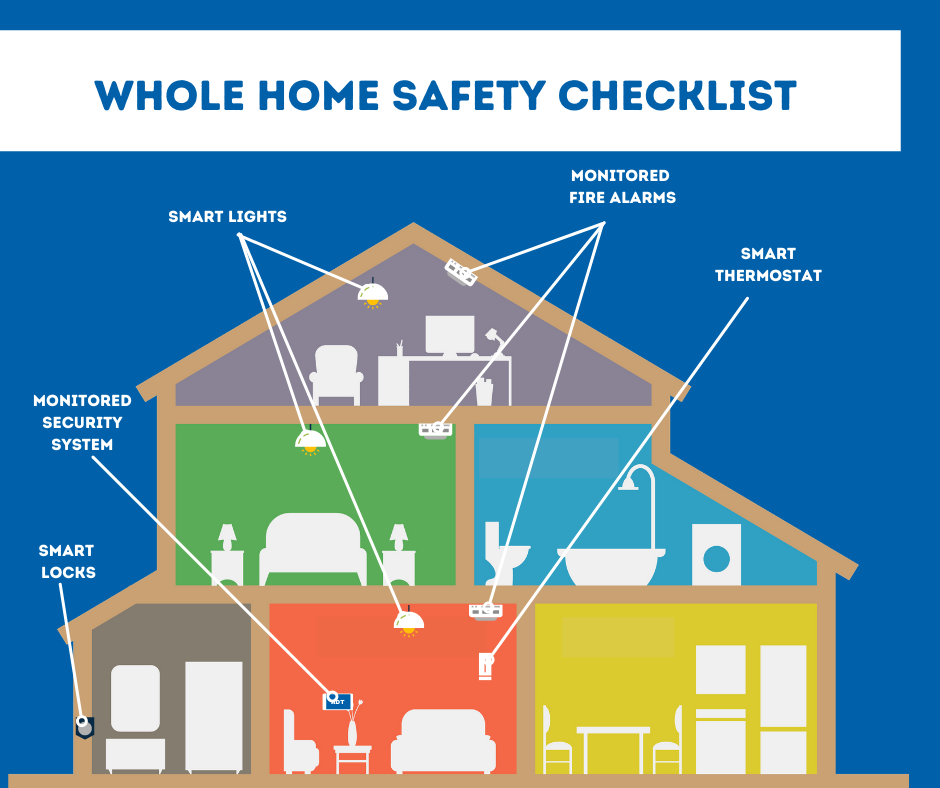
Whole Home Safety Checklist for Dayton
While you may want to employ a individual room method for home safety, there are some methods that work for the entire house approach. These devices can link with one another through a smart hub, and oftentimes react to other things. You can also control all your home safety equipment using a smartphone app, such as ADT Control:
-
Monitored Security System: Each one of your entryways should use a sensor that warns you to forced entry. After the alarm trips, your monitoring expert answers the call and immediately contacts emergency personnel.
-
Smart Lights For Each Room: Sure, you can schedule your smart lights to make your home more efficient. But they can also allow you to keep safe in an emergency. Have your smart bulbs come on when a security alarm trips to frighten off burglars or brighten your way to a outside location.
-
Smart Thermostat: Like your smart lights, a smart thermostat in Dayton could save you 10%-15% in utility costs. Also, it can turn on your exhaust fan if you have a fire.
-
Monitored Fire Detectors: It’s code that you should have a smoke detector on every level of your house. You can improve your fire game by installing a monitored fire alarm that detects excessive heat and smoke, and pings your 24/7 monitoring experts when it detects a fire.
-
Smart Locks: Every entryway that utilizes a keyed lock can upgrade to a smart door lock. Now you can program numbered codes to friends and family and get texts to your phone when your locks are unlocked. Your locks can even automatically turn off, helping you to quickly leave if you have an emergency.

Family Room/Living Room Safety Checklist For Dayton
You’ll hang out most in your family room, so it may be the best room to improve your home safety. Highly sought after items, like a big screen or video game console, typically reside in your living room, making it an alluring space for thieves. Start with installing a motion sensor or indoor camera in there, then take a look at the following safety protocols:
-
Motion Sensors: By installing motion detectors, you’ll have a loud noise if they detect unexpected movement within your family room. The best devices are motion detectors that aren’t set off by a dog or cat or you’ll see your sirens go off every time your cat comes in for a drink of water.
-
Indoor Security Camera: An indoor security camera puts a constant watch on your living room. Watch constant streams of everything so you can find out what’s going on from the mobile app. Or chat with your kids in the living room by using the two-way talk feature.
-
Surge Protector/Outlet Maintenance: Make sure you protect those electronics and quit overloading your circuits with a surge protector. For additional comfort, set up a smart plug with surge protection built-in.
-
Entertainment Center Attached To The Wall: If you have babies or toddlers, you’ll need to bolt your entertainment center or other heavy furniture to a wall. This is especially crucial if your family room uses carpet that can make furniture extra wobbly.
-
Special Locks For Sliding Glass Doors: If your family room has a sliding glass door that opens to a backyard, deck, or outside porch, you get that the door lock is pretty flimsy. Put in a special lock, like a metal bar or locks that are located on the top and bottom of the frame.
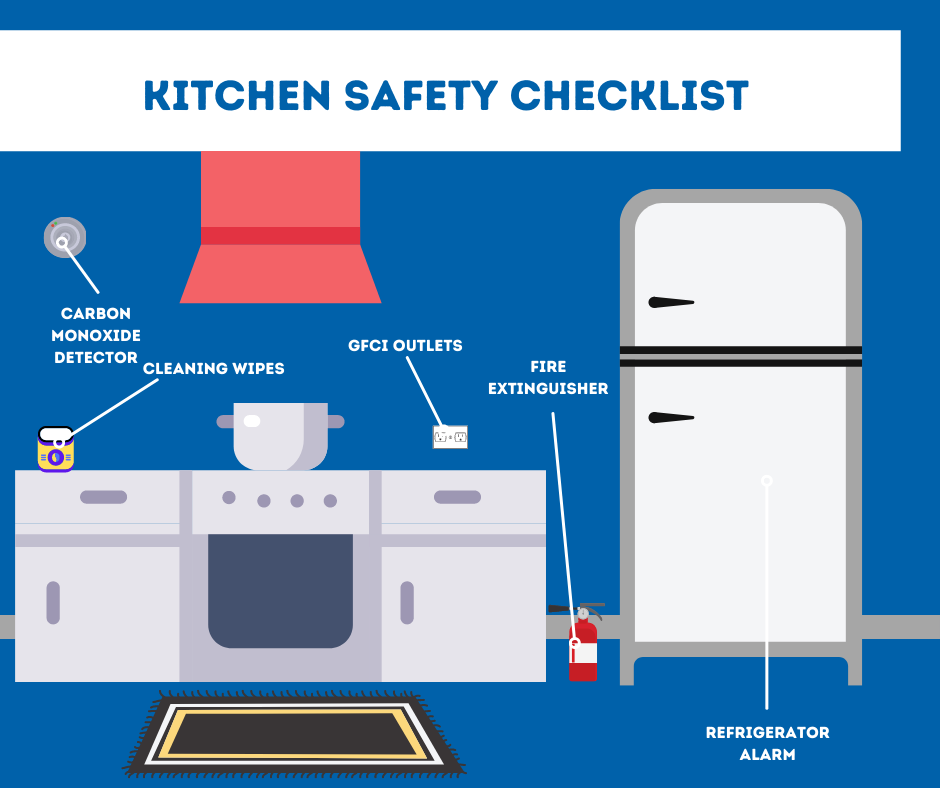
Kitchen Safety Checklist For Dayton
Your kitchen has room for items that can add safety and security to your house. Some of these items are also a snap to add and can be bought from the a retail store:
-
Fire Extinguisher: A fire can come from from an unwatched skillet or a towel that’s too close to a burner. Always have a fire extinguisher at the ready for any stove or oven emergencies.
-
Circuit Interrupter Box On Every Outlet: A GFCI outlet should be used anywhere there’s nearby water to ward off a deadly shock. That means the outlets by your sink and kitchen counter. Since the late ‘80s, it’s been code to have one circuit interrupter outlet per circuit. But for simplicity’s sake, you’re going to want to use a single GFCI per outlet.
-
Monitored Carbon Monoxide Detector: A CO detector is advised for the kitchen if you have natural gas for the oven and range. If your gas burners spring a leak, the CO detector will cause a high-decibel siren and contact your monitoring center.
-
Disinfectant Wipes Or Spray: The biggest safety problem in the kitchen is actually bacteria and protein that comes with uncooked meat and other foods. Always have antiviral wipes or an antibacterial spray to clean your area when making a meal.
-
Refrigerator Alarm: The items in the refrigerator need to remain at a constant temperature to stay healthy to use. If you accidently leave the freezer or refrigerator door open too long, then an alarm beep will let you know so you can check the seal. Some refrigerators already have a pre-installed alarm, others don’t, and you’ll have to buy a fridge alarm from the hardware store.
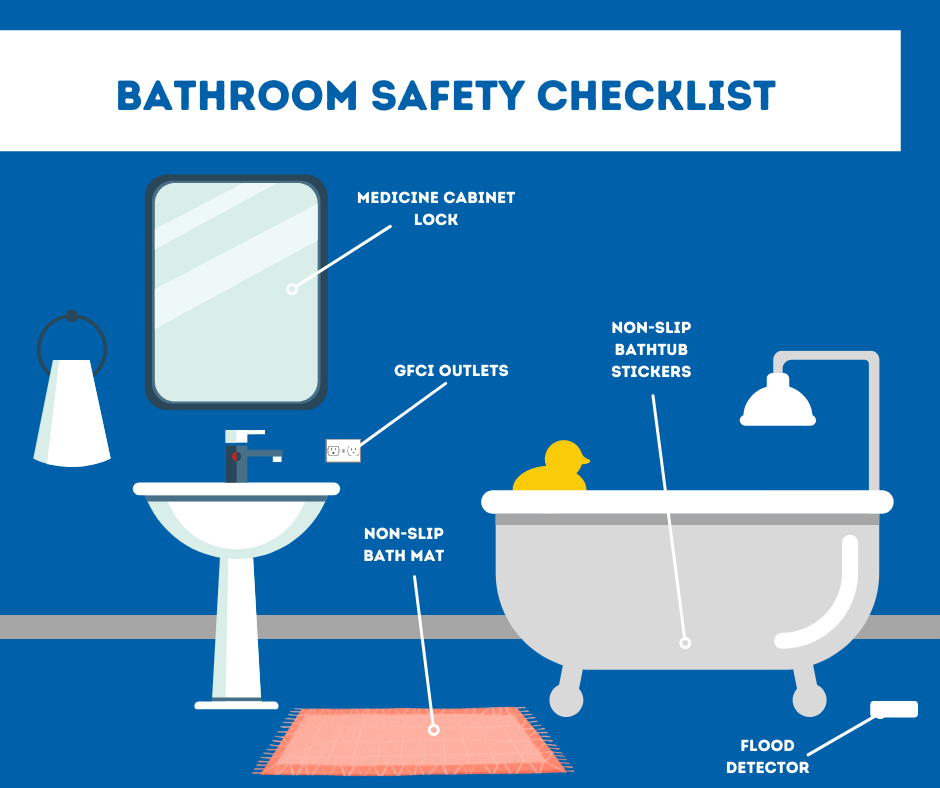
Bathroom Safety Checklist For Dayton
Just because there’s not a lot of square footage in your bathroom, you will still have safety issues. From water problems to electric safety, here are a few safety tips for your bathroom:
-
Flood Detectors: A leaking sink or bathtub can lead to a whole lot of damage. Find out early about pooling water with a flood detector before they generate hundreds to thousands of dollars in renovations.
-
Non-slip Shower Mats: A slip and fall in the bathroom can be a painful occurrence, causing bumps, sore joints, or sprained ankles. Make sure you avoid these issues with a no-slip bath mat for your wet feet.
-
No-slip Bathtub Strips: Another water hazard, a tub can be a slippery area to move in. It’s a good idea that each tub has some textured strips so your feet and toes have a bumpy patch to gain traction.
-
Medicine Door Latch: If you have young kids or someone with memory complications, you need to take extra attention regarding prescription medicine. Secure your pills and syrups by installing a medicine cabinet with a latch that locks.
-
GFCI Circuits: Similarly to the kitchen, you will have to also use a grounded GFCI outlet on each bathroom outlet. This will shut off the current if water splashes on them or they experience a sudden jolt from a hair dryer or curling iron.
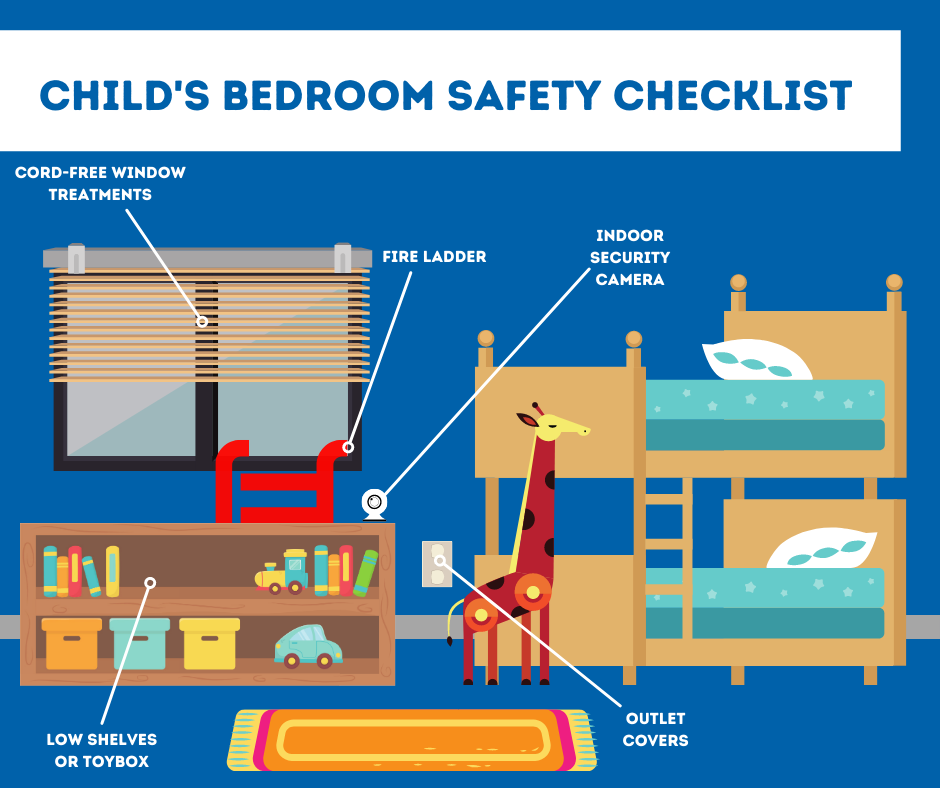
Child’s Bedroom Safety Checklist For Dayton
A child’s bedroom should counterbalance safety with simplicity. If their window treatments or other things are safe but tricky to operate, then your children may get around the device with dangerous methods -- like shimmying up a dresser -- to use them. Here are 5 easy, yet safe, ideas:
-
Cordless Window Coverings: Safety professionals have designated corded window treatments a hidden problem for kids and pets. Install motorized treatments that you can easily manage via remote. Or go state-of-the-art and connect your shades to your ADT smart hub so they rise without anyone’s help when it’s time to get up, and lower in the evening for added darkness.
-
Indoor Security Camera: A security camera perched on your child’s desk can double as an HD baby monitor that you can watch from a mobile device. And when they want you, they can hit the 2-way talk button on the camera.
-
Plug Covers: While every outlet should use covers on them for your little children, this is especially important in their bedroom. It’s the main place in your home where your toddler will most likely play alone without consistent parental supervision.
-
Window Fire Ladder: If you have bedrooms on the second floor, then you should put in a window safety ladder. These should let a young one leave the house even if the stairway or ground floor are blocked off with fire. Just remember to practice how to unfurl the ladder one or two times a year.
-
Toy Chest Or Low Bookshelves: It’s strange to view a toy chest as a safety item, but you’ll understand if you’ve ever walked on a Lego in your bare feet. A uncluttered floor gives your child a quick way out when there’s an emergency.
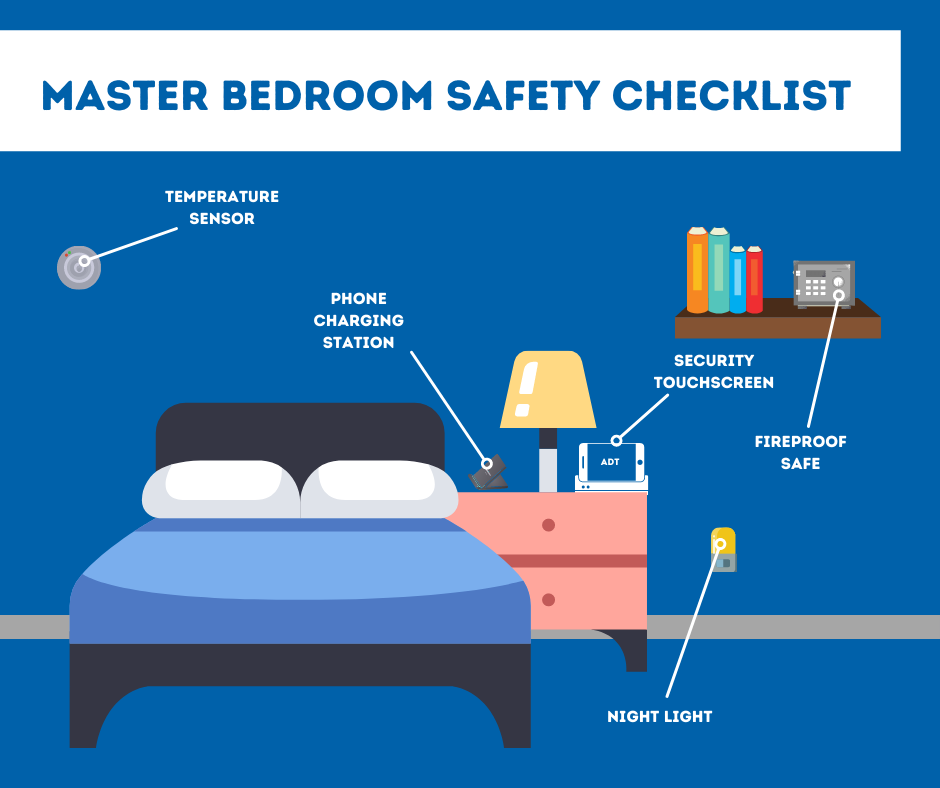
Main Bedroom Safety Checklist For Dayton
Your main bedroom should be an oasis, so let your safety components make life easier if there's an emergency. After all, being startled awake by a high-decibel siren can be confusing.
-
Smart Hub Touchscreen: Having a smart hub on your bedside table gives you a sense of what’s happening without getting out of bed. You could always log into your ADT smartphone app. However, the HD touchscreen may be easier to use to use when you’re bleary-eyed and disoriented.
-
Personal Charging Stand: We rely on our smartphones for so much now alarm clocks, news readers, time wasters, and maybe even phones. The only problem is that an uncharged cell will cut us off from reaching help if during an emergency. To make sure your phone always works, a an easy-to-use charging station is should be used nightly.
-
Nightlight/Smart Lights: A plug-in light can calm you when you’re startled awake from an alarm or other sounds. If you have trouble falling asleep with an outlet light, install a smart bulb in your fixtures. Then you can get light simply with a push of a button or voice direction.
-
Fireproof Safe: Store your important papers like insurance cards, medical information, or a bankbook in a fireproof lockbox. Your lockbox can be a big one that is located out of the way or a small portable lockbox that you can carry when you leave during a fire or break-in.
-
Temperature Sensor: The problem with a master bedroom is that they tend to feel too hot or be frigid since they sit far away from the thermostat. A heat sensor can communicate to your smart thermostat so you can have a comfortable, relaxing sleep at a wonderful climate.
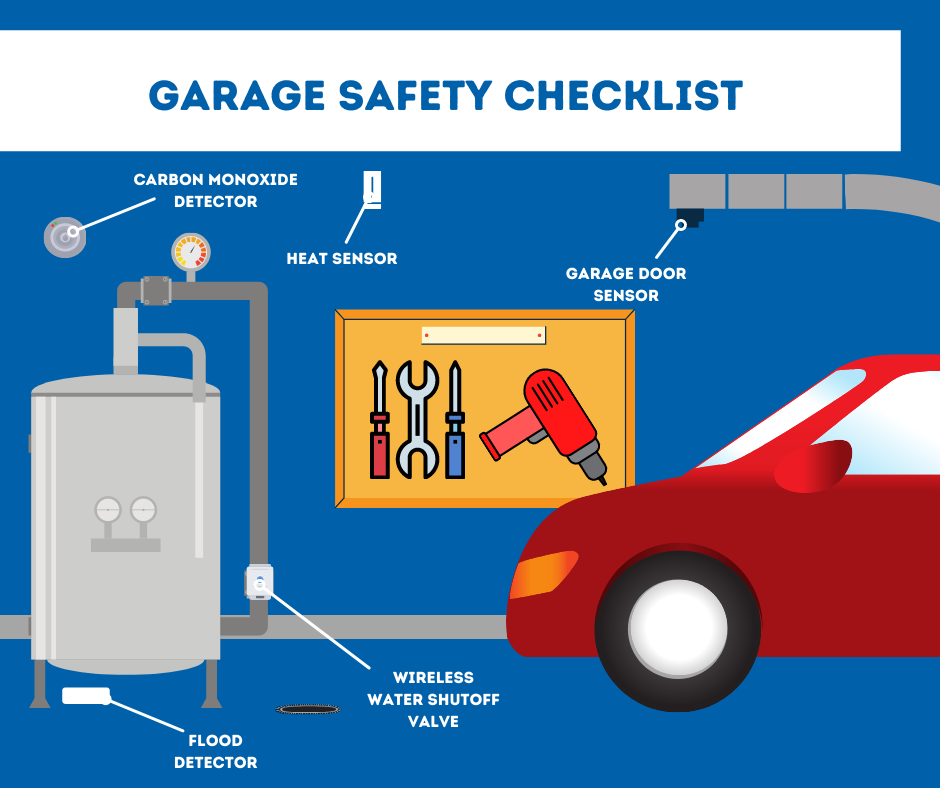
Garage/Basement Safety Checklist For Dayton
Most safety issues in the garage or basement have to do with your water or HVAC system. Finding problems before they start can stave away more devastating problems in the future. So, as you look around your storage areas, take note of these critical items:
-
Flood Detector Or Sump Pump Alarm: Placing a flood sensor by your water heater and sump pump can prevent you from wading into a pond when you go into your basement or garage. The last you need is to spend the weekend getting rid of standing water and sorting through all those storage boxes.
-
CO Alarm: It’s smart to have a CO detector in an area where a gas leak can happen. If you use a gas furnace, you should install a detector in the same room as your unit.
-
Remote Water Shutoff Valve: If your water detector finds a hot water heater leak or a busted pipe, then you will have to shut off the main water valve at once. With a wireless shutoff valve, you can stop water flow from anywhere in the world. That’s perfect when you’re out of town and receive a water leak notification on your smartphone.
-
Garage Door Sensor: Leaving the garage door open leads to all sorts of problems. You can waste HVAC energy through that open door, and critters or thieves can just saunder in. A sensor will notify you about a neglected garage door and lets you lower it with your phone.
-
Temperature Sensor: A temperature sensor in your basement or garage is essential if you fret about frozen pipes. The heat in these areas can be surprisingly different than the main part of the house, so you may want to keep a closer eye on the temperature through the ADT mobile app.
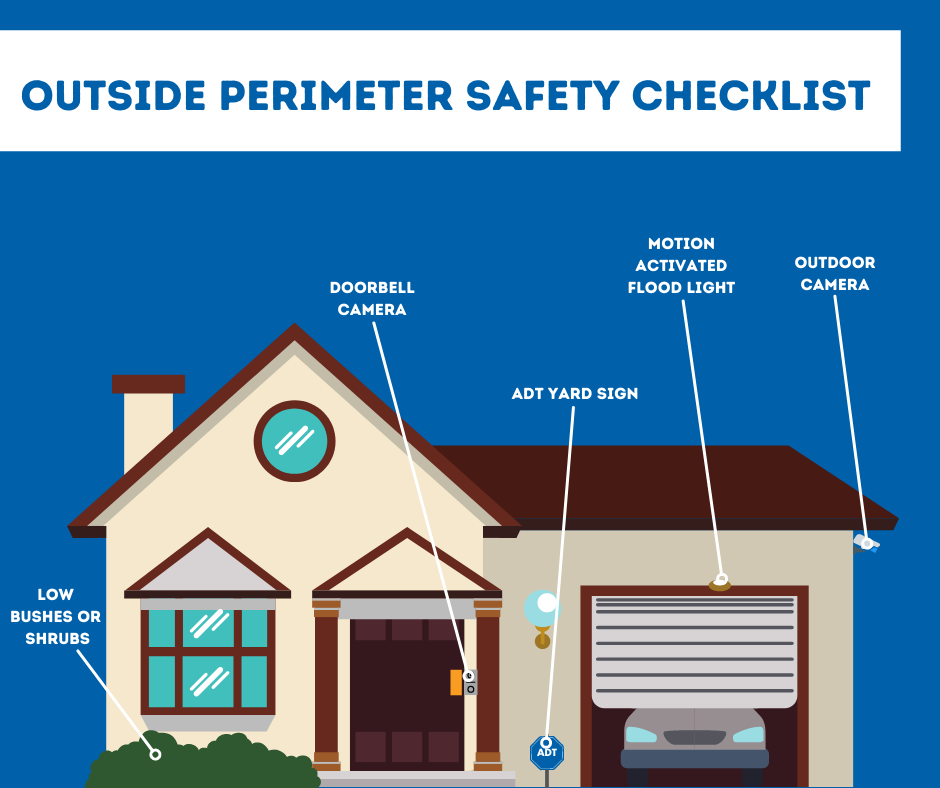
Home Perimeter Safety Checklist for Dayton
Your front yard, drive, and front step are just as important to secure as the rest of your home. Use this checklist to defend your perimeter:
-
Doorbell Camera: See who’s arrived at the front door before you answer it and talk to guests. View packages and review video clips if they are taken.
-
Outdoor Camera: You can hang outdoor cameras to notify you about suspicious lurkers in your back yard. These cameras come in handy in areas where you might not have a window installed -- like around a cellar or by the driveway.
-
Window Height Shrubbery: Overgrown foliage can give you some privacy, but they also block your line of sight of the yard and curb. Don’t offer potential intruders a dark shadow to hide. Plus, tall bushes or foliage around your home can obstruct gutters and bring in bugs.
-
ADT Signs And Decals: One of the biggest deterrents for a break-in is alerting would-be intruders that you use a state-of-the-art home security system. An ADT yard sign by the main walk and a window sticker will show people that they should shove off to an less prepared target.
-
Motion Triggered Porch Lights: Light is the greatest enemy to those who skulk in the shadows. Motion-activated lighting on your deck, patio, or garage can frighten lurkers away. Lights also help you work the locks when you arrive back home late at night.
Call Secure24 Alarm Systems To Help You With Your Home Safety Checklist for Dayton
While Secure24 Alarm Systems can’t help you with non-security devices on your Dayton home safety checklist, we can offer a customized home security. With everything from alarms to thermostats, we can customize the best system for your house’s needs. Just contact (937) 230-5750 for more information or fill out the form below. Or customize your own system with our Security System Designer.
